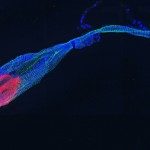Lien vers Pubmed [PMID] – 11053135
Biophys. J. 2000 Nov;79(5):2624-31
PMP1 is a 38-residue plasma membrane protein of the yeast Saccharomyces cerevisiae that regulates the activity of the H(+)-ATPase. The cytoplasmic domain conformation results in a specific interfacial distribution of five basic side chains, thought to strongly interact with anionic phospholipids. We have used the PMP1 18-38 fragment to carry out a deuterium nuclear magnetic resonance ((2)H-NMR) study for investigating the interactions between the PMP1 cytoplasmic domain and phosphatidylserines. For this purpose, mixed bilayers of 1-palmitoyl, 2-oleoyl-sn-glycero-3-phosphocholine (POPC) and 1-palmitoyl, 2-oleoyl-sn-glycero-3-phosphoserine (POPS) were used as model membranes (POPC/POPS 5:1, m/m). Spectra of headgroup- and chain-deuterated POPC and POPS phospholipids, POPC-d4, POPC-d31, POPS-d3, and POPS-d31, were recorded at different temperatures and for various concentrations of the PMP1 fragment. Data obtained from POPS deuterons revealed the formation of specific peptide-POPS complexes giving rise to a slow exchange between free and bound PS lipids, scarcely observed in solid-state NMR studies of lipid-peptide/protein interactions. The stoichiometry of the complex (8 POPS per peptide) was determined and its significance is discussed. The data obtained with headgroup-deuterated POPC were rationalized with a model that integrates the electrostatic perturbation induced by the cationic peptide on the negatively charged membrane interface, and a “spacer” effect due to the intercalation of POPS/PMP1f complexes between choline headgroups.

